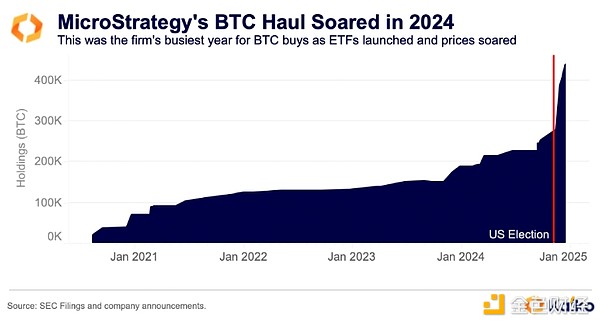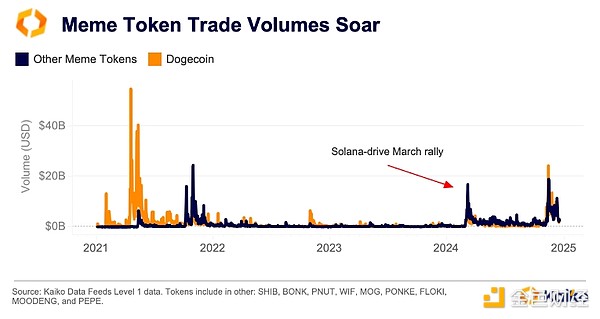Source: Kaiko Research
Translation: Deng Tong, Jinse Finance
1. The Road to BTC's $100,000 Milestone
2024 has been a successful year for Bitcoin. With the launch of spot BTC exchange-traded funds in January, the market has gradually matured, and the fourth halving has proceeded smoothly.
Even several billion-dollar liquidations and sell-offs could not stop BTC's success this year. The price of BTC, measured in dollars, has risen nearly 140% year-to-date, with even larger gains compared to other fiat currencies (some of which experienced significant devaluation in 2019).

2. U.S. Election Stimulates Bullish Bets
The 2024 U.S. election holds significant importance for cryptocurrencies. Bitcoin and digital assets have never received so much attention on the world stage—at least not such positive attention.
President Trump expressed support for progressive regulation and open dialogue with the industry during the summer. Shortly after an assassination attempt against him, he even appeared at the Bitcoin Nashville conference. Most of the cryptocurrency community rallied around the Republican candidate and the eventual Democratic candidate Kamala Harris, beginning to take some positive actions regarding cryptocurrencies.
Before the election on November 5, Bitcoin saw market participants engaging in a "Trump trade." A special election contract on Deribit attracted billions in trading volume and open contracts before the election, and shortly after, traders betting on historical highs showed significant bullish tendencies. They were right; by November, BTC trading volume had exceeded $75,000.
The overall Senate voting results and the final vote were widely considered favorable for cryptocurrencies. As a result, BTC led the post-election surge in crypto assets, breaking through $80,000 by November 11.
As we have shown above, the increasingly bullish sentiment persisted from the remainder of November into December, with Bitcoin's current historical high exceeding $107,000.

3. Bitcoin's Transaction Fees Surge Before Fourth Halving
The fourth halving of Bitcoin occurred on April 19 this year. On that Saturday, the average transaction fee for Bitcoin surged to a historic high of $146. This was significantly higher than Ethereum's average fee of $3 on the same day.
The historic surge in Bitcoin network fees may be the most important development of its fourth quarter. Despite warning signs, it caught many market participants by surprise.

Casey Rodarmor, the founder of Ordinals, announced plans to launch Runes, a protocol that allows for easier issuance of fungible tokens on Bitcoin. However, based on the impact of Ordinals on transaction fees, users may have anticipated the rise in fees, but the historic increase still surprised many.
Ordinals allow node operators to inscribe data and images onto newly created Bitcoin blocks. These so-called "registrations" are similar to NFTs, increasing demand for Bitcoin block space and raising the fees earned by BTC miners.
The launch of Runes proceeded in a similar manner. The introduction of the protocol led to increased demand for block space, which in turn affected fees.
4. BlackRock Surpasses Grayscale
BTC ETFs broke various records this year, with the total assets managed by 11 funds rising to over $100 billion.
BlackRock emerged as the big winner, indicating significant institutional interest in Bitcoin and digital assets. Its spot BTC ETF manages over $55 billion in assets, surpassing Grayscale's GBTC within months. GBTC, launched by digital asset management company Grayscale in 2013, was largely a cryptocurrency-first product, and its significant premium/discount to net asset value limited institutional buying. Therefore, after the ETF launch this year, it was quickly surpassed by BlackRock.

After the company decided to maintain fees at 1.5%, GBTC experienced asset outflows for most of this year. In the U.S. ETF space, companies are accustomed to low fees, leading most Wall Street firms to prefer BlackRock and Fidelity over GBTC.
5. ETH/BTC Ratio Declines
Since the merge, the ETH/BTC ratio has continued to decline, showing no signs of slowing down in 2024. This ratio compares the performance of the two assets, and it decreases when Ethereum underperforms Bitcoin.
Other factors contributing to the decline include the rise of Solana, as users migrated to cheaper networks during the speculative activities in March and the fourth quarter of this year. Meme tokens (which we will discuss later) are behind much of the speculation, driving Solana DEX trading volume to sometimes exceed that of Ethereum this year.
In November, it fell to 0.033, the lowest level since March 2021. What is behind the poor performance? Since the merge, ETH has faced significant regulatory pressure, as staking in the U.S. has come under close scrutiny, provoking the ire of the SEC.

6. Slow Start: ETH ETF Launch
The ETH ETF has had a slow start since its launch in July. Similar to the launch of the BTC ETF, Grayscale's fund has again put pressure on the market, as the digital asset management company maintained fees at 2%.
However, after the outflows from Grayscale's ETHE decreased, the newly launched funds began to see inflows by the end of 2024. Since the U.S. election in November, inflows have significantly increased, with traders flocking to CME's ETH futures. This reflects similar activities seen when traders executed arbitrage trades on BTC futures in May and June.
The open interest in ETH futures has been steadily increasing, and the changing regulatory outlook has reversed the trend for the ETH ETF, with net flows turning positive by the end of November and into December. The net flow since its launch has now exceeded $2 billion, including over $3 billion in outflows from ETHE.

ETH is set to be one of the biggest winners from the regime change in Washington, D.C. While it has lagged behind Bitcoin this year, the regulatory shifts brought about by the change in the U.S. government will greatly benefit the second-largest asset by market capitalization. The classification of ETH as a commodity or security and the clarity around staking could be two major drivers of growth next year.
7. Trendsetting MicroStrategy Buys More BTC Than Ever
MicroStrategy has experienced its busiest year yet in purchasing BTC. The business software company has transformed in many ways from its core business this year. Chairman and former CEO Michael Saylor even referred to his company as the world's first "Bitcoin financial company" in the third-quarter earnings report in November.

Since January, MicroStrategy has purchased over 249,850 Bitcoins, accelerating its buying pace since the U.S. election, with its holdings nearly doubling in the past month. The company has issued multiple convertible bonds to fund its acquisitions, raising concerns among some market participants that a price crash could adversely affect the company and even lead to forced selling.
Currently, this strategy is paying off. The rapid rise in BTC prices and the bullish sentiment in the market have caused MSTR's value to soar to historic highs. MSTR has reached new highs for the first time in 24 years since the dot-com bubble burst in March 2000.
While MicroStrategy is a pioneer in corporate Bitcoin purchases, some Republican lawmakers hope the U.S. government will follow suit. Senator Cynthia Lummis has pledged to establish a strategic Bitcoin reserve after Donald Trump wins the U.S. presidential election.
8. Alameda Gap Narrows After ETF Listing
This year, the crypto market has finally put the collapse of FTX in the past. The liquidity gap left by the collapse of FTX and its sister company Alameda Research (also known as the Alameda Gap) has narrowed this year.
With the rise in prices and the continuous growth of market share, Bitcoin's 1% market depth this year has surpassed the previous level of about $120 million before FTX. The recoveries of Kraken, Coinbase, and LMAX Digital are particularly notable. Notably, the Bitcoin market depth at LMAX, which is institution-focused, reached a record $27 million this week, briefly surpassing Bitstamp to become the third-largest liquidity Bitcoin market.

9. Meme Token Frenzy
As mentioned above, meme tokens have seen exponential surges at different times this year. In particular, tokens on Solana experienced significant growth due to the launch of Pump dot fun, a protocol for launching meme tokens that allows anyone to issue tokens and build liquidity from scratch through word-of-mouth and participation.
However, familiar assets largely dominated trading volumes on centralized exchanges. Similar to the pre-2021 surge, Dogecoin has once again become favored by traders—also due to post-election bullish sentiment. Dogecoin rose after incoming President Donald Trump revealed plans to establish a "Department of Government Efficiency" (D.O.G.E.) led by Elon Musk and Vivek Ramaswamy.

One of the new tokens launched on Solana this year is PNUT, which has captured people's imagination, inspired by Peanut the Squirrel (a pet influencer from New York), whose untimely passing led to significant online support (and token issuance).
One trader even turned a $16 investment in PNUT into $3 million in realized profits. PNUT is currently trading on several major centralized exchanges, including Binance, Crypto.com, and OKX.
10. Regulatory Changes Impact Stablecoin Market
Since June, European regulations have been reshaping the stablecoin market. The landmark European Markets in Crypto-Assets Regulation (MiCA) has triggered a wave of stablecoin delistings and product supply adjustments by major exchanges.
Throughout 2024, trading volume of euros against cryptocurrencies has remained above last year's average, indicating growing demand. Three months after the enactment of MiCA, the euro-backed stablecoin market underwent significant changes driven by the rise of MiCA-compliant alternatives. By November 2024, MiCA-compliant euro stablecoins (including Circle's EURC, Société Générale's EURCV, and Banking Circle's EURI) accounted for a record 91% market share.

After Binance listed EURI at the end of August, it has become a major player in the euro stablecoin market, comparable to Coinbase. Nevertheless, with the support of Circle's EURC, Coinbase remains the largest market player, holding a 47% share.
Conclusion
This year has been significant for establishing digital assets as viable assets for Wall Street investors. Time will tell whether the industry can sustain growth in the coming months and years, but this rebound feels different.
The 2024 rebound is built on the arrival of established companies with risk frameworks (currently including BTC and ETH). With regulatory shifts and changes in market structure, next year's rally is expected to extend beyond Bitcoin and into other assets.
免责声明:本文章仅代表作者个人观点,不代表本平台的立场和观点。本文章仅供信息分享,不构成对任何人的任何投资建议。用户与作者之间的任何争议,与本平台无关。如网页中刊载的文章或图片涉及侵权,请提供相关的权利证明和身份证明发送邮件到support@aicoin.com,本平台相关工作人员将会进行核查。




